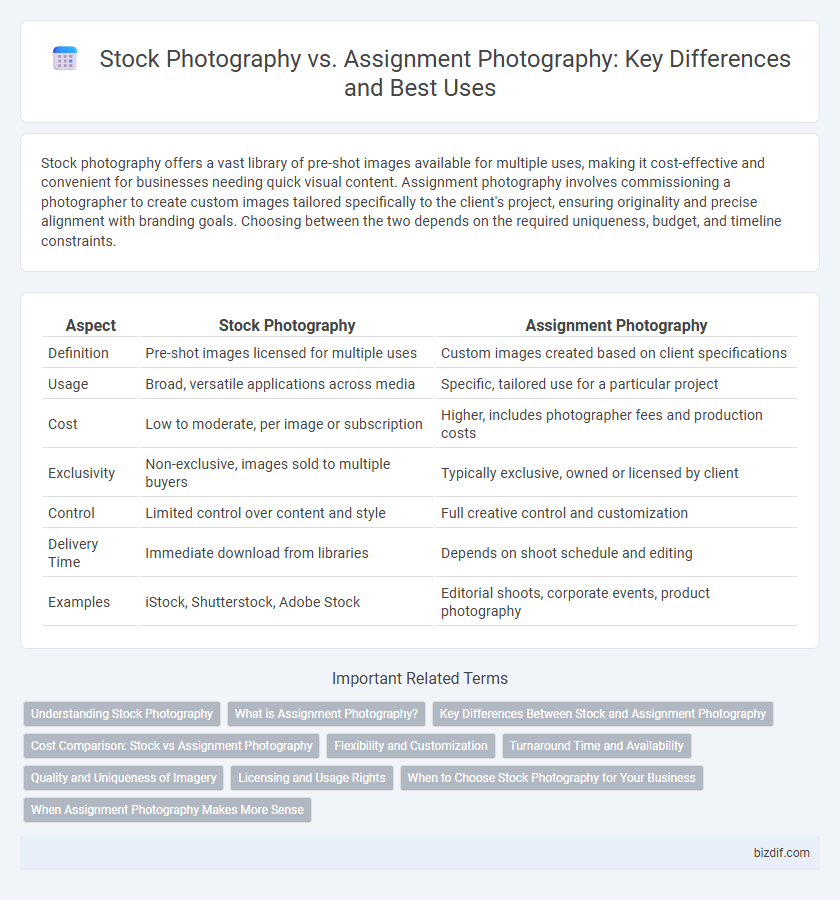Stock photography offers a vast library of pre-shot images available for multiple uses, making it cost-effective and convenient for businesses needing quick visual content. Assignment photography involves commissioning a photographer to create custom images tailored specifically to the client's project, ensuring originality and precise alignment with branding goals. Choosing between the two depends on the required uniqueness, budget, and timeline constraints.
Table of Comparison
| Aspect | Stock Photography | Assignment Photography |
|---|---|---|
| Definition | Pre-shot images licensed for multiple uses | Custom images created based on client specifications |
| Usage | Broad, versatile applications across media | Specific, tailored use for a particular project |
| Cost | Low to moderate, per image or subscription | Higher, includes photographer fees and production costs |
| Exclusivity | Non-exclusive, images sold to multiple buyers | Typically exclusive, owned or licensed by client |
| Control | Limited control over content and style | Full creative control and customization |
| Delivery Time | Immediate download from libraries | Depends on shoot schedule and editing |
| Examples | iStock, Shutterstock, Adobe Stock | Editorial shoots, corporate events, product photography |
Understanding Stock Photography
Stock photography involves the creation and sale of pre-shot images that can be licensed multiple times for various purposes, offering flexibility to businesses needing versatile visuals quickly. These images are typically captured without a specific client brief, allowing photographers to build extensive portfolios that cater to broad market demands such as advertising, blogs, and websites. Licensing models for stock photos often include royalty-free or rights-managed options, providing buyers with scalable usage rights depending on their project requirements.
What is Assignment Photography?
Assignment photography involves a photographer being hired to capture specific images tailored to a client's needs, often for commercial, editorial, or advertising purposes. This type of photography requires understanding the client's brief, location scouting, and sometimes working under tight deadlines to produce unique, custom content. Unlike stock photography, assignment photography offers exclusive, original images that directly address a particular project or campaign.
Key Differences Between Stock and Assignment Photography
Stock photography consists of pre-shot images available for licensing, offering diverse visuals covering a broad range of subjects without exclusivity. Assignment photography involves customized shoots tailored to specific client requirements, ensuring exclusive rights and precise content matching. The key differences lie in usage rights, exclusivity, content control, and client involvement in the creative process.
Cost Comparison: Stock vs Assignment Photography
Stock photography offers a cost-effective solution with images priced per download or subscription, often significantly lower than custom shoots. Assignment photography involves higher expenses due to specialized planning, location fees, equipment rentals, and professional photographer rates tailored to client-specific projects. Businesses seeking budget-friendly options typically prefer stock photography, while assignments are ideal for unique, high-quality visual needs requiring customization.
Flexibility and Customization
Stock photography offers flexibility by providing a vast library of ready-to-use images suitable for diverse projects, enabling quick access without the need for a tailored shoot. Assignment photography delivers high customization through personalized photo sessions designed to meet specific client requirements, ensuring unique and targeted visual content. Choosing between the two depends on the balance between immediate availability and bespoke creative control in visual storytelling.
Turnaround Time and Availability
Stock photography offers immediate availability with a vast library of pre-shot images, allowing for instant use in projects. Assignment photography requires a tailored shoot, resulting in longer turnaround times due to planning, execution, and post-processing phases. Clients seeking quick access prioritize stock photography, while those needing customized content opt for assignments despite the extended delivery timeframe.
Quality and Uniqueness of Imagery
Stock photography offers a vast library of pre-shot images that prioritize generic appeal and broad market use, often resulting in more common visual themes with moderate quality. Assignment photography delivers highly customized, unique images tailored to specific client needs, ensuring superior quality through personalized shoots and professional attention to detail. The distinct advantage of assignment photography lies in its exclusivity and ability to capture bespoke moments, setting it apart from the mass-produced nature of stock photos.
Licensing and Usage Rights
Stock photography offers pre-licensed images with standardized usage rights, allowing buyers to use photos across multiple projects without custom negotiations, often under royalty-free or rights-managed licenses. Assignment photography involves bespoke image creation with tailored licensing agreements that specify exclusive usage rights, usage duration, and scope, granting clients greater control and exclusivity. Understanding these licensing differences is essential for businesses seeking compliant image use aligned with their marketing or editorial needs.
When to Choose Stock Photography for Your Business
Stock photography is ideal for businesses needing a cost-effective, quick solution with diverse, pre-shot images available for immediate use. It suits marketing campaigns, website design, and social media content where generic visuals suffice without the need for customization. Choosing stock photography saves time and budget while providing access to a vast library of high-quality images covering a wide range of subjects.
When Assignment Photography Makes More Sense
Assignment photography makes more sense when clients require tailored images that align precisely with their brand identity and marketing objectives. It ensures exclusivity and control over content, offering higher compensation compared to stock photography's often lower, one-time fees. This approach is ideal for businesses seeking unique, high-quality visuals for campaigns, product launches, or corporate communications.
Stock Photography vs Assignment Photography Infographic

 bizdif.com
bizdif.com